MGT5OBR: Organizational Behavior and Employee Management in Telecom
VerifiedAdded on 2023/03/30
|6
|1039
|64
Report
AI Summary
This report analyzes organizational behavior in relation to effective employee management within Orange Telecommunications, a fictional company specializing in smartphone and tablet hardware and software. It focuses on the servant leadership behavioral theory as a framework for addressing conflict, teamwork, and decision-making challenges. The report highlights the importance of effective hiring practices, leveraging theories like the personality-job fit, and emphasizes the role of teamwork and decision-making in fostering cooperation and organizational growth. It addresses the issue of conflict stemming from factors like lack of trust and unclear goals, and proposes the servant leadership model to prioritize employee needs, build stronger relationships, and enhance job satisfaction. The report concludes with recommendations for implementing servant leadership, including involving managers in decision-making and maintaining a balance between employee support and constructive criticism, ultimately aiming to improve employee performance and organizational success.
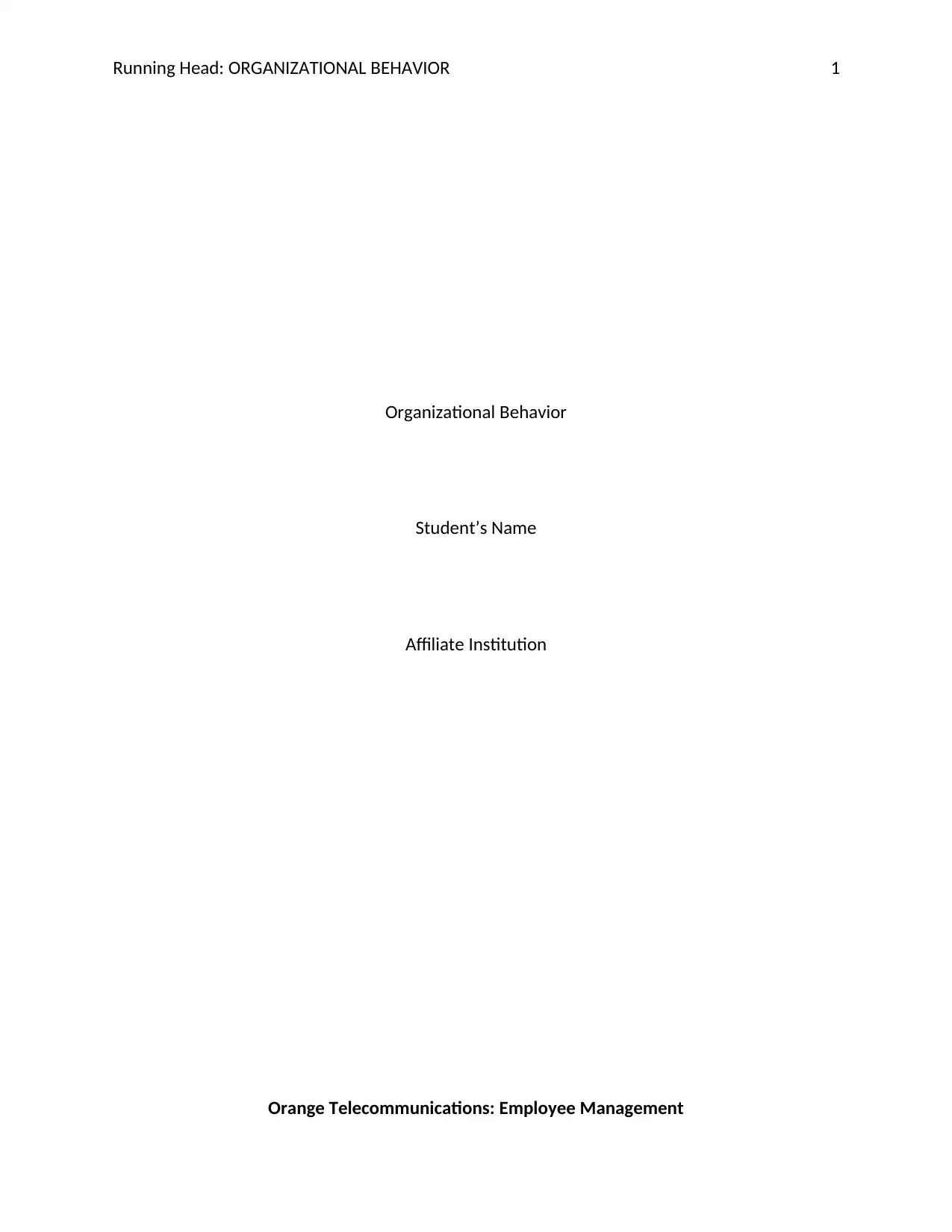
Running Head: ORGANIZATIONAL BEHAVIOR 1
Organizational Behavior
Student’s Name
Affiliate Institution
Orange Telecommunications: Employee Management
Organizational Behavior
Student’s Name
Affiliate Institution
Orange Telecommunications: Employee Management
Paraphrase This Document
Need a fresh take? Get an instant paraphrase of this document with our AI Paraphraser
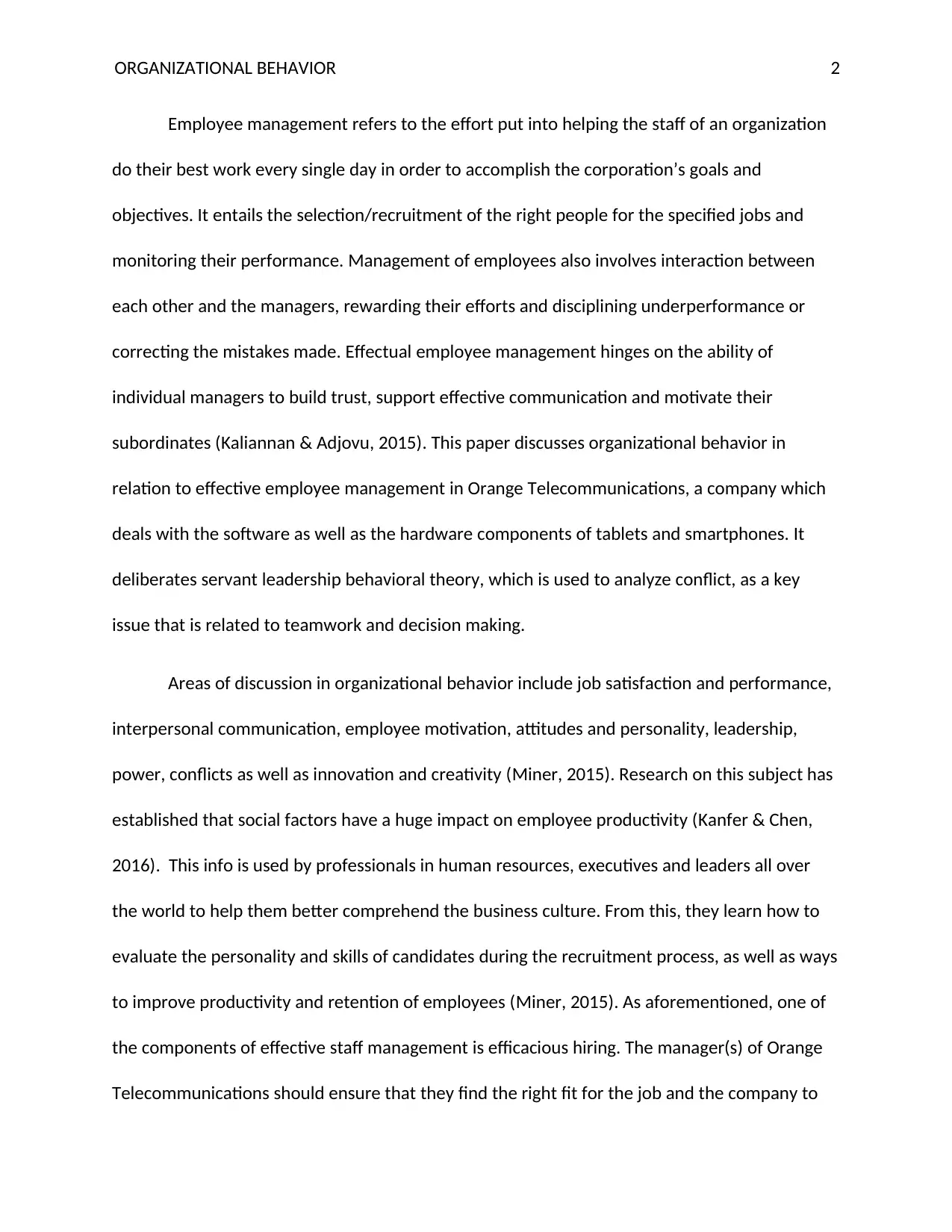
ORGANIZATIONAL BEHAVIOR 2
Employee management refers to the effort put into helping the staff of an organization
do their best work every single day in order to accomplish the corporation’s goals and
objectives. It entails the selection/recruitment of the right people for the specified jobs and
monitoring their performance. Management of employees also involves interaction between
each other and the managers, rewarding their efforts and disciplining underperformance or
correcting the mistakes made. Effectual employee management hinges on the ability of
individual managers to build trust, support effective communication and motivate their
subordinates (Kaliannan & Adjovu, 2015). This paper discusses organizational behavior in
relation to effective employee management in Orange Telecommunications, a company which
deals with the software as well as the hardware components of tablets and smartphones. It
deliberates servant leadership behavioral theory, which is used to analyze conflict, as a key
issue that is related to teamwork and decision making.
Areas of discussion in organizational behavior include job satisfaction and performance,
interpersonal communication, employee motivation, attitudes and personality, leadership,
power, conflicts as well as innovation and creativity (Miner, 2015). Research on this subject has
established that social factors have a huge impact on employee productivity (Kanfer & Chen,
2016). This info is used by professionals in human resources, executives and leaders all over
the world to help them better comprehend the business culture. From this, they learn how to
evaluate the personality and skills of candidates during the recruitment process, as well as ways
to improve productivity and retention of employees (Miner, 2015). As aforementioned, one of
the components of effective staff management is efficacious hiring. The manager(s) of Orange
Telecommunications should ensure that they find the right fit for the job and the company to
Employee management refers to the effort put into helping the staff of an organization
do their best work every single day in order to accomplish the corporation’s goals and
objectives. It entails the selection/recruitment of the right people for the specified jobs and
monitoring their performance. Management of employees also involves interaction between
each other and the managers, rewarding their efforts and disciplining underperformance or
correcting the mistakes made. Effectual employee management hinges on the ability of
individual managers to build trust, support effective communication and motivate their
subordinates (Kaliannan & Adjovu, 2015). This paper discusses organizational behavior in
relation to effective employee management in Orange Telecommunications, a company which
deals with the software as well as the hardware components of tablets and smartphones. It
deliberates servant leadership behavioral theory, which is used to analyze conflict, as a key
issue that is related to teamwork and decision making.
Areas of discussion in organizational behavior include job satisfaction and performance,
interpersonal communication, employee motivation, attitudes and personality, leadership,
power, conflicts as well as innovation and creativity (Miner, 2015). Research on this subject has
established that social factors have a huge impact on employee productivity (Kanfer & Chen,
2016). This info is used by professionals in human resources, executives and leaders all over
the world to help them better comprehend the business culture. From this, they learn how to
evaluate the personality and skills of candidates during the recruitment process, as well as ways
to improve productivity and retention of employees (Miner, 2015). As aforementioned, one of
the components of effective staff management is efficacious hiring. The manager(s) of Orange
Telecommunications should ensure that they find the right fit for the job and the company to
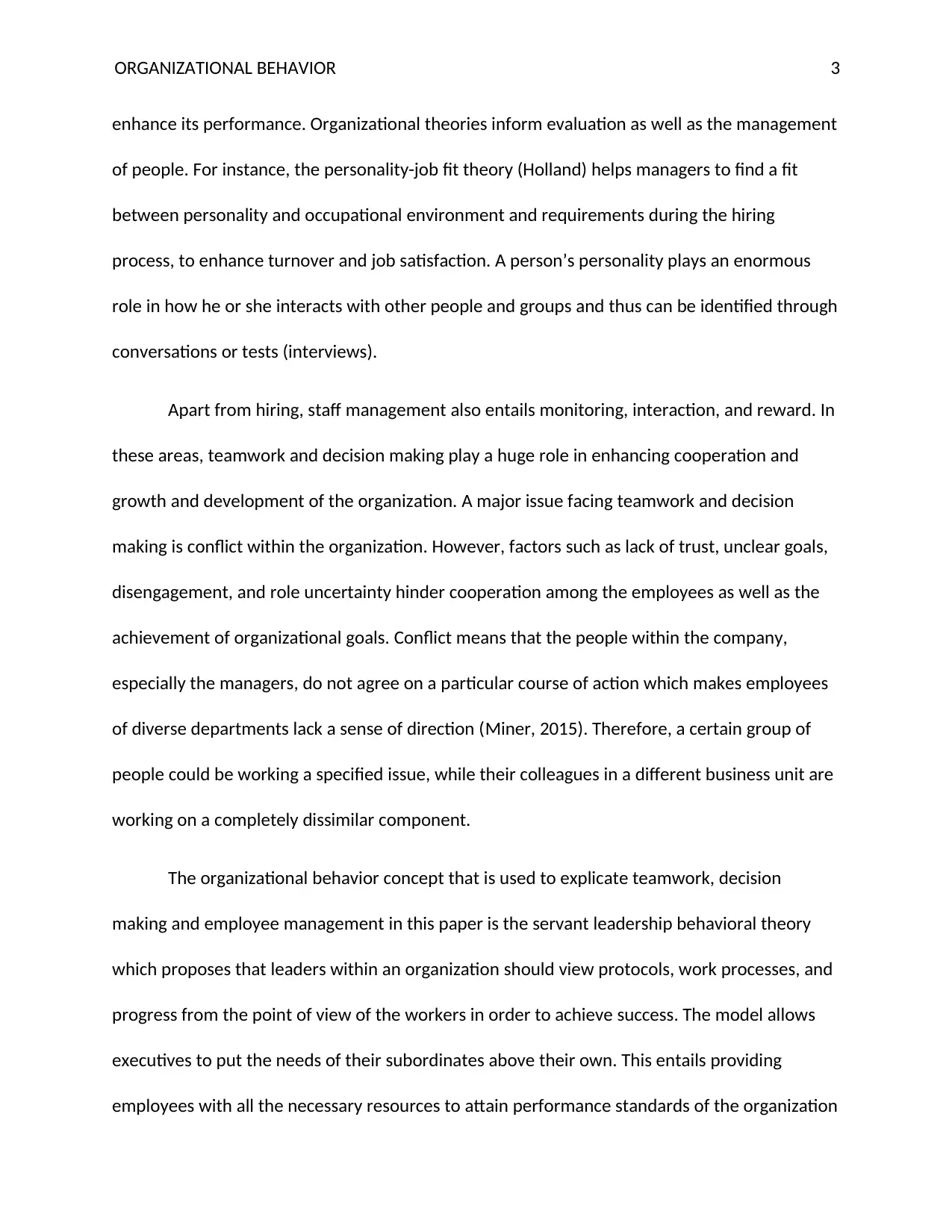
ORGANIZATIONAL BEHAVIOR 3
enhance its performance. Organizational theories inform evaluation as well as the management
of people. For instance, the personality-job fit theory (Holland) helps managers to find a fit
between personality and occupational environment and requirements during the hiring
process, to enhance turnover and job satisfaction. A person’s personality plays an enormous
role in how he or she interacts with other people and groups and thus can be identified through
conversations or tests (interviews).
Apart from hiring, staff management also entails monitoring, interaction, and reward. In
these areas, teamwork and decision making play a huge role in enhancing cooperation and
growth and development of the organization. A major issue facing teamwork and decision
making is conflict within the organization. However, factors such as lack of trust, unclear goals,
disengagement, and role uncertainty hinder cooperation among the employees as well as the
achievement of organizational goals. Conflict means that the people within the company,
especially the managers, do not agree on a particular course of action which makes employees
of diverse departments lack a sense of direction (Miner, 2015). Therefore, a certain group of
people could be working a specified issue, while their colleagues in a different business unit are
working on a completely dissimilar component.
The organizational behavior concept that is used to explicate teamwork, decision
making and employee management in this paper is the servant leadership behavioral theory
which proposes that leaders within an organization should view protocols, work processes, and
progress from the point of view of the workers in order to achieve success. The model allows
executives to put the needs of their subordinates above their own. This entails providing
employees with all the necessary resources to attain performance standards of the organization
enhance its performance. Organizational theories inform evaluation as well as the management
of people. For instance, the personality-job fit theory (Holland) helps managers to find a fit
between personality and occupational environment and requirements during the hiring
process, to enhance turnover and job satisfaction. A person’s personality plays an enormous
role in how he or she interacts with other people and groups and thus can be identified through
conversations or tests (interviews).
Apart from hiring, staff management also entails monitoring, interaction, and reward. In
these areas, teamwork and decision making play a huge role in enhancing cooperation and
growth and development of the organization. A major issue facing teamwork and decision
making is conflict within the organization. However, factors such as lack of trust, unclear goals,
disengagement, and role uncertainty hinder cooperation among the employees as well as the
achievement of organizational goals. Conflict means that the people within the company,
especially the managers, do not agree on a particular course of action which makes employees
of diverse departments lack a sense of direction (Miner, 2015). Therefore, a certain group of
people could be working a specified issue, while their colleagues in a different business unit are
working on a completely dissimilar component.
The organizational behavior concept that is used to explicate teamwork, decision
making and employee management in this paper is the servant leadership behavioral theory
which proposes that leaders within an organization should view protocols, work processes, and
progress from the point of view of the workers in order to achieve success. The model allows
executives to put the needs of their subordinates above their own. This entails providing
employees with all the necessary resources to attain performance standards of the organization
⊘ This is a preview!⊘
Do you want full access?
Subscribe today to unlock all pages.

Trusted by 1+ million students worldwide
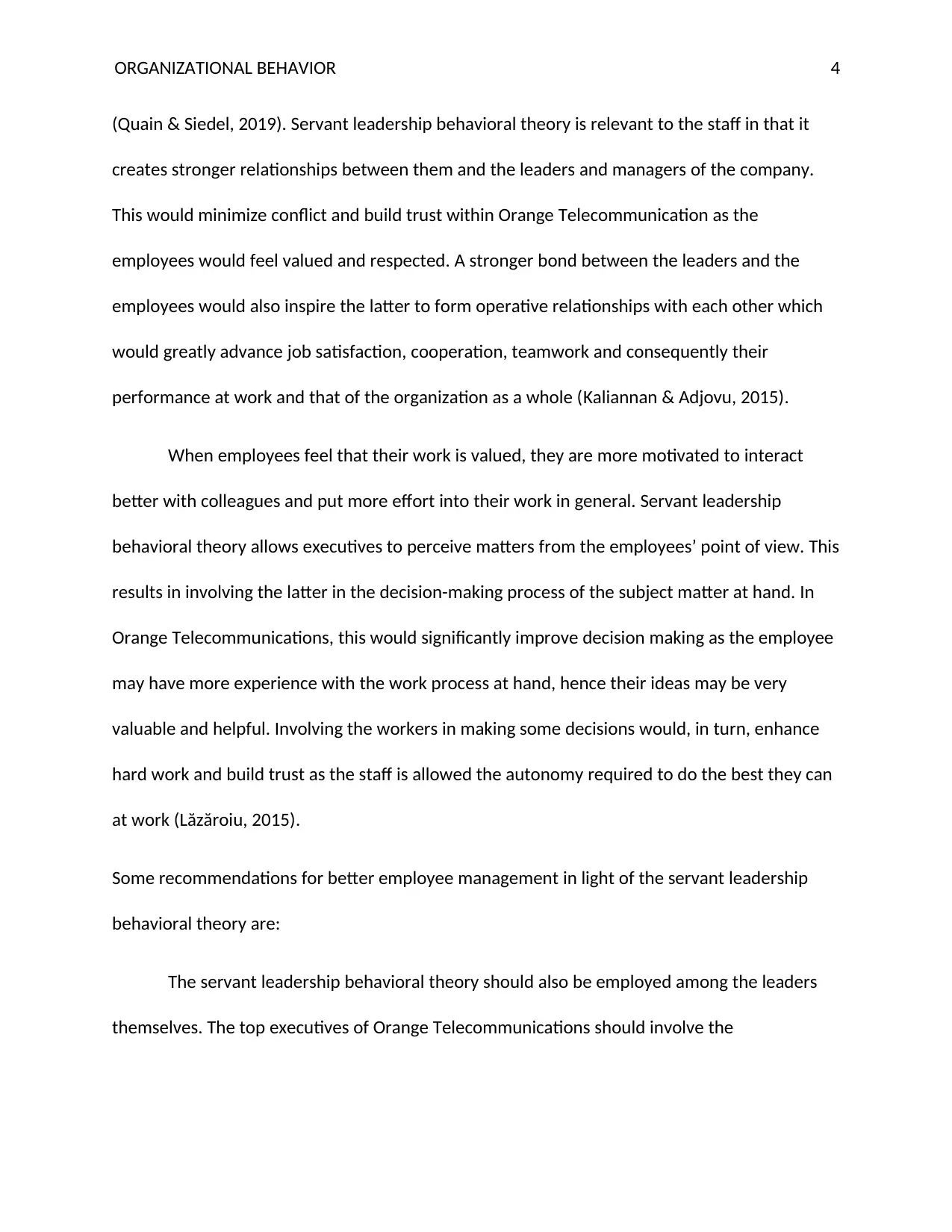
ORGANIZATIONAL BEHAVIOR 4
(Quain & Siedel, 2019). Servant leadership behavioral theory is relevant to the staff in that it
creates stronger relationships between them and the leaders and managers of the company.
This would minimize conflict and build trust within Orange Telecommunication as the
employees would feel valued and respected. A stronger bond between the leaders and the
employees would also inspire the latter to form operative relationships with each other which
would greatly advance job satisfaction, cooperation, teamwork and consequently their
performance at work and that of the organization as a whole (Kaliannan & Adjovu, 2015).
When employees feel that their work is valued, they are more motivated to interact
better with colleagues and put more effort into their work in general. Servant leadership
behavioral theory allows executives to perceive matters from the employees’ point of view. This
results in involving the latter in the decision-making process of the subject matter at hand. In
Orange Telecommunications, this would significantly improve decision making as the employee
may have more experience with the work process at hand, hence their ideas may be very
valuable and helpful. Involving the workers in making some decisions would, in turn, enhance
hard work and build trust as the staff is allowed the autonomy required to do the best they can
at work (Lăzăroiu, 2015).
Some recommendations for better employee management in light of the servant leadership
behavioral theory are:
The servant leadership behavioral theory should also be employed among the leaders
themselves. The top executives of Orange Telecommunications should involve the
(Quain & Siedel, 2019). Servant leadership behavioral theory is relevant to the staff in that it
creates stronger relationships between them and the leaders and managers of the company.
This would minimize conflict and build trust within Orange Telecommunication as the
employees would feel valued and respected. A stronger bond between the leaders and the
employees would also inspire the latter to form operative relationships with each other which
would greatly advance job satisfaction, cooperation, teamwork and consequently their
performance at work and that of the organization as a whole (Kaliannan & Adjovu, 2015).
When employees feel that their work is valued, they are more motivated to interact
better with colleagues and put more effort into their work in general. Servant leadership
behavioral theory allows executives to perceive matters from the employees’ point of view. This
results in involving the latter in the decision-making process of the subject matter at hand. In
Orange Telecommunications, this would significantly improve decision making as the employee
may have more experience with the work process at hand, hence their ideas may be very
valuable and helpful. Involving the workers in making some decisions would, in turn, enhance
hard work and build trust as the staff is allowed the autonomy required to do the best they can
at work (Lăzăroiu, 2015).
Some recommendations for better employee management in light of the servant leadership
behavioral theory are:
The servant leadership behavioral theory should also be employed among the leaders
themselves. The top executives of Orange Telecommunications should involve the
Paraphrase This Document
Need a fresh take? Get an instant paraphrase of this document with our AI Paraphraser
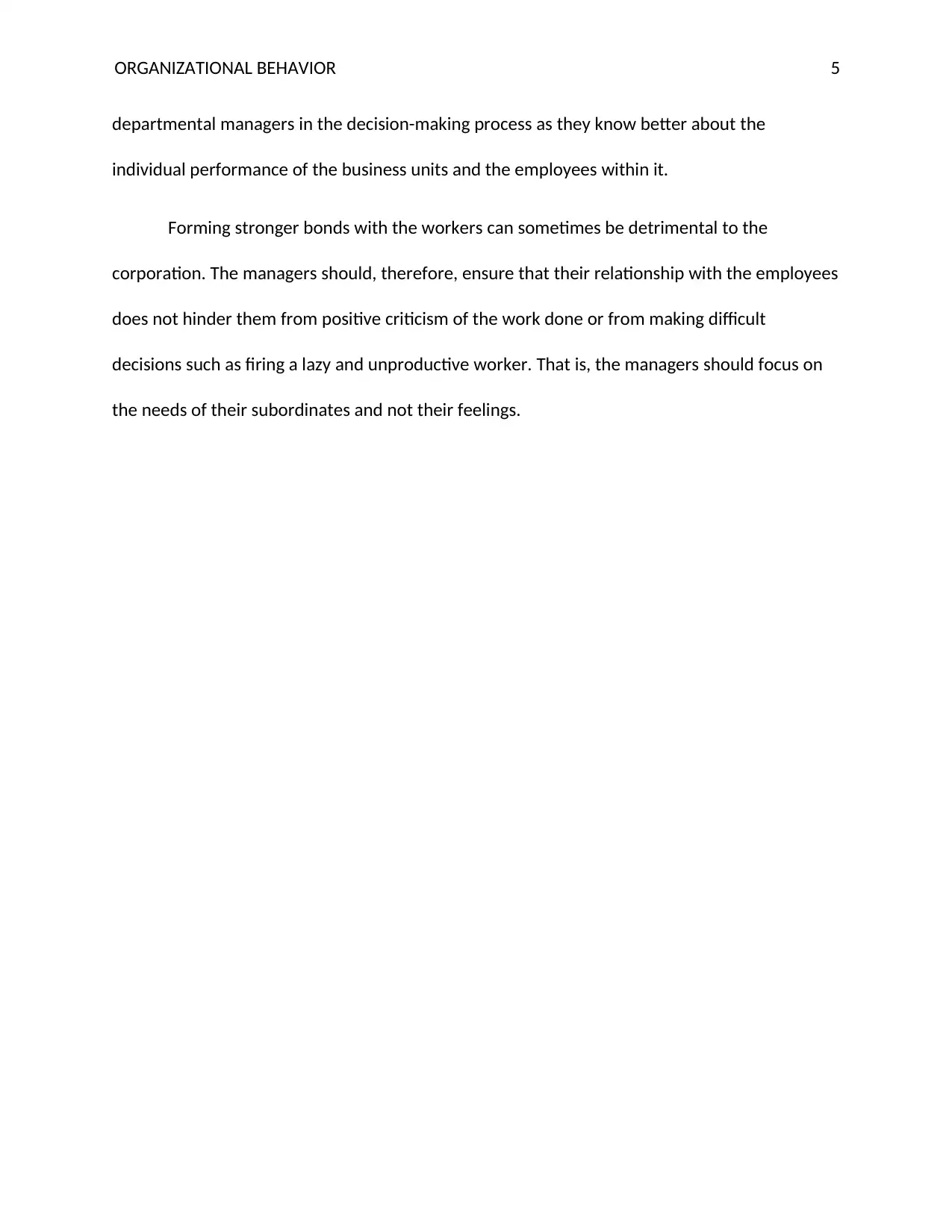
ORGANIZATIONAL BEHAVIOR 5
departmental managers in the decision-making process as they know better about the
individual performance of the business units and the employees within it.
Forming stronger bonds with the workers can sometimes be detrimental to the
corporation. The managers should, therefore, ensure that their relationship with the employees
does not hinder them from positive criticism of the work done or from making difficult
decisions such as firing a lazy and unproductive worker. That is, the managers should focus on
the needs of their subordinates and not their feelings.
departmental managers in the decision-making process as they know better about the
individual performance of the business units and the employees within it.
Forming stronger bonds with the workers can sometimes be detrimental to the
corporation. The managers should, therefore, ensure that their relationship with the employees
does not hinder them from positive criticism of the work done or from making difficult
decisions such as firing a lazy and unproductive worker. That is, the managers should focus on
the needs of their subordinates and not their feelings.
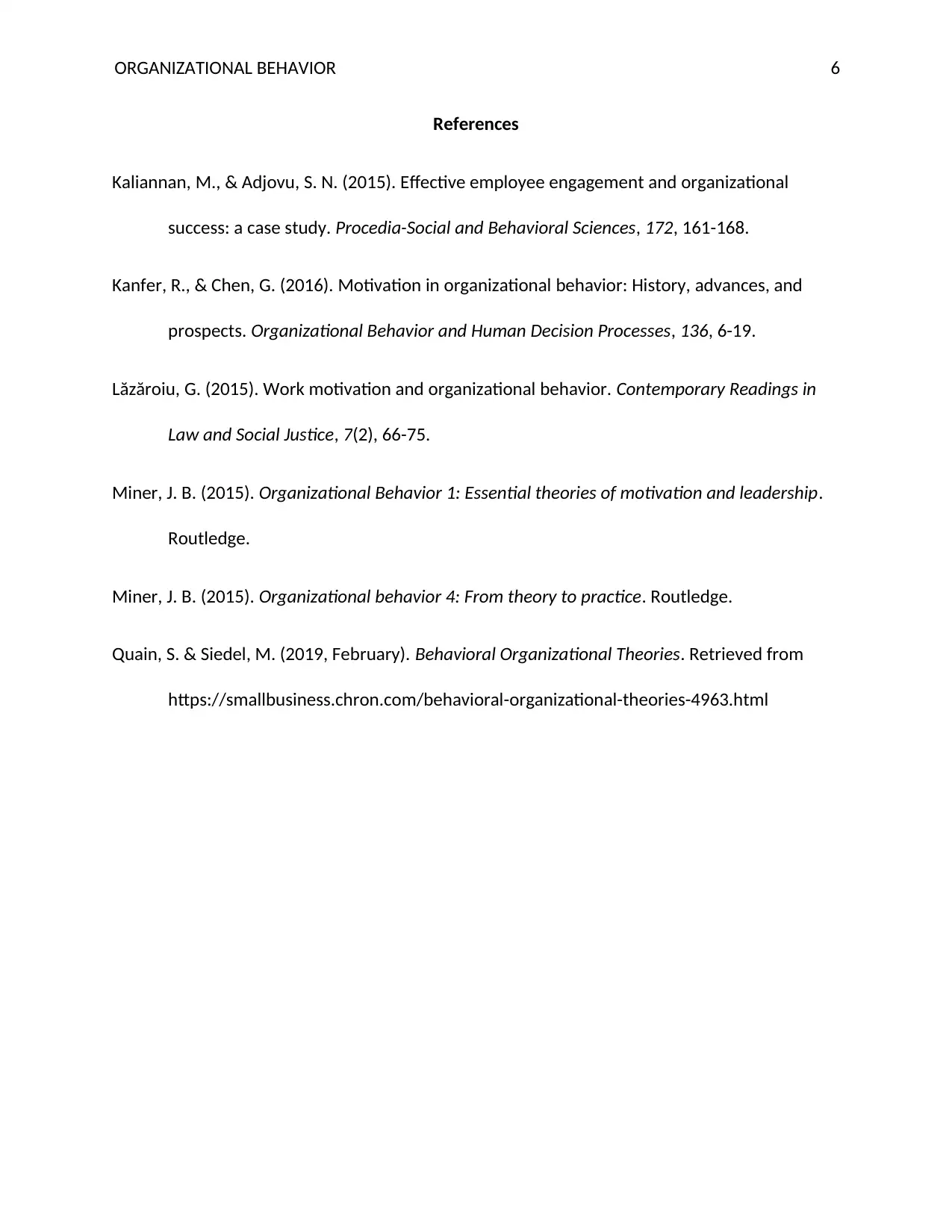
ORGANIZATIONAL BEHAVIOR 6
References
Kaliannan, M., & Adjovu, S. N. (2015). Effective employee engagement and organizational
success: a case study. Procedia-Social and Behavioral Sciences, 172, 161-168.
Kanfer, R., & Chen, G. (2016). Motivation in organizational behavior: History, advances, and
prospects. Organizational Behavior and Human Decision Processes, 136, 6-19.
Lăzăroiu, G. (2015). Work motivation and organizational behavior. Contemporary Readings in
Law and Social Justice, 7(2), 66-75.
Miner, J. B. (2015). Organizational Behavior 1: Essential theories of motivation and leadership.
Routledge.
Miner, J. B. (2015). Organizational behavior 4: From theory to practice. Routledge.
Quain, S. & Siedel, M. (2019, February). Behavioral Organizational Theories. Retrieved from
https://smallbusiness.chron.com/behavioral-organizational-theories-4963.html
References
Kaliannan, M., & Adjovu, S. N. (2015). Effective employee engagement and organizational
success: a case study. Procedia-Social and Behavioral Sciences, 172, 161-168.
Kanfer, R., & Chen, G. (2016). Motivation in organizational behavior: History, advances, and
prospects. Organizational Behavior and Human Decision Processes, 136, 6-19.
Lăzăroiu, G. (2015). Work motivation and organizational behavior. Contemporary Readings in
Law and Social Justice, 7(2), 66-75.
Miner, J. B. (2015). Organizational Behavior 1: Essential theories of motivation and leadership.
Routledge.
Miner, J. B. (2015). Organizational behavior 4: From theory to practice. Routledge.
Quain, S. & Siedel, M. (2019, February). Behavioral Organizational Theories. Retrieved from
https://smallbusiness.chron.com/behavioral-organizational-theories-4963.html
⊘ This is a preview!⊘
Do you want full access?
Subscribe today to unlock all pages.

Trusted by 1+ million students worldwide
1 out of 6
Related Documents
Your All-in-One AI-Powered Toolkit for Academic Success.
+13062052269
info@desklib.com
Available 24*7 on WhatsApp / Email
![[object Object]](/_next/static/media/star-bottom.7253800d.svg)
Unlock your academic potential
Copyright © 2020–2025 A2Z Services. All Rights Reserved. Developed and managed by ZUCOL.



